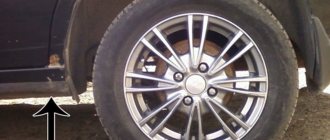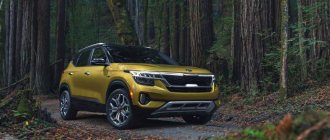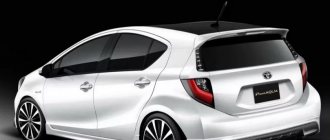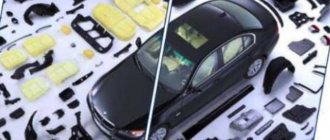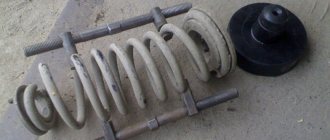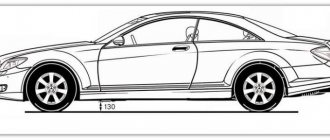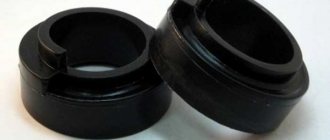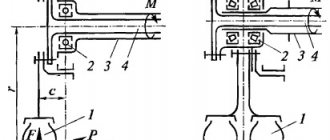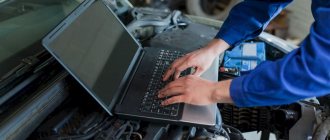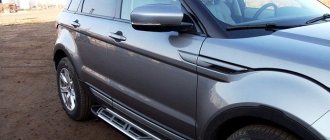Ground clearance is the distance between the road surface and the lowest point in the center of the vehicle.
Ground clearance differs on different cars; the car may have:
- large (high) ground clearance (from 20 cm);
- average ground clearance (15-18 cm);
- small ground clearance (less than 13 cm).
It is important to understand that ground clearance has a significant impact on cross-country ability, controllability, stability and a number of other indicators. For this reason, it is necessary to separately take into account a number of nuances when choosing a car. Read more in our article.
Ground clearance: what is car clearance and what does it affect?
First of all, ground clearance is the distance between the supporting surface and the lowest point of the central part of the car. Said central part is that part which is enclosed between two planes.
These planes are parallel to the longitudinal plane of symmetry of the car and stand the same (equal) relative to the inner surface of the wheels. At the same time, the amount of ground clearance is an important criterion for many car owners when buying a car.
What can we perform there?
The first thing that will suffer when encountering a deep pothole or an open sewer hatch is, of course, the front bumper. As soon as the car dives into such a hole (look at the photo), you are guaranteed a split bumper. Let's not talk about dented wheels and sills now.
There are no general standards, but there are average values for cars, family cars, and SUVs that reflect the ground clearance (distance from the front bumper to the asphalt):
- for SUVs from 18 to 35 cm;
- for passenger cars from 13 to 20 cm.
Next in line for the “breakdown”, and in the direction of travel, we have the oil pan. That's who gets it to the fullest. No, no, you’ll hear from a friend that he broke through the pan. And this is already a very expensive repair. The pan itself, changing the oil, or even worse, if you didn’t immediately notice the breakdown and drove for some significant distance without oil. Quite often, the clearance between the pan and the ground is even less than from the bumper. To be precise, it is not the pallet itself that sticks out, but its protection. But it’s better to let the ground clearance decrease slightly, by a few centimeters due to protection, than to drive at the risk of damaging the pan.
Here the values are almost the same:
- for an SUV on average from 17 cm;
- for a passenger car from 12 cm.
Elements of the front suspension of some cars (levers, rods) can also significantly reduce ground clearance. Don’t forget about the muffler with a resonator, which, although recessed into the bottom, can easily get caught on the road on some car models.
At one time, as the owner of a VAZ 2112 car, during a year of operation, I managed to puncture the gas tank three times. This is all to blame, of course, for the disgusting directions and also weak rear springs, because of which the ground clearance in the middle part of my car was indecently small, and at any opportunity I clung to obstacles with this element. After the third time, I was already seriously concerned about this issue (I still think, why not after the second), and I changed the springs along with the tank. I installed new ones from model 11, since it is half a turn longer. I really don’t know if this solved the problem, because I sold the car almost immediately.
How to determine car clearance
Vehicle clearance is one of the indicators that is necessarily reflected in the technical data of the car. Accordingly, you can simply use an Internet search to find out what ground clearance a particular car has.
Please note: The vehicle clearance value from the manufacturer is relevant if no tuning activities have been carried out on the vehicle. For example, you want to know the ground clearance of a Skoda Rapid
It is enough to apply this request to the search, from where it will become clear that the 2021 model has a ground clearance of 170 mm. This is slightly more than many budget class passenger cars, for example, the Hyundai Solaris has a ground clearance of 160 mm, but the Russian Lada Vesta has a higher ground clearance - 175-178 mm
For example, you want to know the ground clearance of a Skoda Rapid. It is enough to apply this request to the search, from where it will become clear that the 2021 model has a ground clearance of 170 mm. This is slightly more than many budget class passenger cars, for example, the Hyundai Solaris has a ground clearance of 160 mm, but the Russian car Lada Vesta has a higher ground clearance - 175-178 mm.
Please note: Vehicle clearance may vary depending on the countries where they are delivered. Since Russia has far from the best roads, European manufacturers often customize the car’s suspension upon delivery in a special way, and equip it with additional crankcase protection (may be offered as an option)
Installing a crankcase protection reduces ground clearance.
Let's take action: how to adjust the clutch on a VAZ 2114 car yourself?
The essence of the operation is to force a change in the length of the cable “jacket”, due to which the clutch pedal stroke changes. To complete the process there is no need for high qualifications - a little free time and desire are enough.
Experts have developed a good algorithm for how to adjust the clutch cable on a VAZ 2114; it consists of the following points:
- Open the engine compartment and disconnect the negative battery.
- For ease of operation, disconnect the hose from the air filter and remove it.
- Using two 17" wrenches, rotate the tip nuts and set the desired pedal stroke.
- Press the clutch pedal several times and measure again the distance from the lower to the upper point of the pedal position.
- Tighten the nuts and install the air filter in its original place.
During setup, you should pay attention to the condition of the cable. If there are abrasions on the “shirt” and the steel fibers are partially torn, then you will have to replace the Lada Samara clutch drive cable
Often there is corrosion on the tip, making it difficult for the nuts to rotate. WD-40 will work to solve the problem. It would be a good idea to inspect the pedal bracket bushings and replace them if they are severely worn.
When you drive Russian cars for a long time, you get used to their peculiar comfort and it seems that everything is not so bad. But as soon as you change to a good foreign car, you immediately realize that you were mistaken.
Modification of the VAZ clutch pedal consists of drilling a hole with a diameter of approximately 6 mm in the plastic bushing into which the fork shaft fits. Or rather, before this you should first select a suitable plug, and then make a hole according to its size.
| Before drilling a hole in the bushing, select a suitable plug to seal it later. |
| Flowing down the shaft, the oil lubricates the upper support and then reaches the lower one. |
Over the course of several days, pour 5–10 drops of motor oil into the hole formed and close it with a stopper. Thus, oil will seep into the gap between the bushing and the fork shaft, flow down the shaft and lubricate the lower support. The clutch pedal will be soft without repairing the gearbox. Lubrication will also eliminate clutch pedal squeaks. Such a modification is suitable not only for the VAZ 2110, but also for the VAZ 2109, because The gearboxes of these cars are of the same type. By the way, if the car is old, then the clutch drive already has wear, distortions and, as a result, difficult movement of the clutch. Fulfill
If you own a car with an automatic transmission, then this article may not seem interesting to you, because now we will talk about an indispensable part for vehicles with a manual transmission. Of course, we mean the clutch pedal, which serves as the main link between the driver’s desire and the “obedience” of the car. To engage or disengage the clutch, a certain force must be applied to the pedal, but if excessive loads are required from the driver, then this is a clear sign of the presence of some problems in the system.
What are the consequences of low vehicle clearance in unsuitable conditions?
If you look at cars in Germany, most of them have a ground clearance between 120 and 140 millimeters. Even crossovers for the local market are made with low ground clearance. The fact is that the roads here in winter and summer meet the highest quality requirements. In our country, everything is somewhat different. If in the summer you can drive along the roads you know in the city with any clearance, then in the winter or along an unfamiliar road you will have to crawl, because you do not know what awaits you in a couple of hundred meters. Low ground clearance will create the following serious troubles for the car owner:
- damage to elements of the lower part of the car when hitting a bump on the road, which visually passes between the wheels of the car;
- problems at speed, when the car is pressed to the track by aerodynamics, and irregularities create large amplitudes of vibration of the stern - you will constantly scratch the road with your rear mudguards and can damage the bumper;
- traveling along a rut on a country road will only cause negative emotions; you will have to move along the “crest of a wave,” which in some cases is not easy, and sometimes simply impossible;
- you will regularly put the car on its belly in the winter, every time you drive into a yard with a knurled rut and ice gouges, you will have to push the car out;
- there will be a need for frequent repairs of various problems, including breakdowns of the chassis, blown boots and sensors of various mechanisms.
As you can see, poor-quality operation of the car is quite possible with just one incorrectly selected parameter. If the ground clearance of your car does not suit you, you can deal with this problem in two ways. The first is purchasing another car with more pronounced ground clearance. The second is the placement of special boosters under the struts, which will provide an additional centimeter of ground clearance. Of course, the latter option often negatively affects the appearance of the car, provided there are no other changes. Many drivers argue that you just need to get used to certain parameters of your car’s ground clearance and know the car’s capabilities. We offer a short video about the effect of a car’s ground clearance on its operation:
How to measure and increase
How to measure?
As mentioned above, knowing the ground clearance of your car, as well as visually representing its size, is very useful. To avoid and skip all obstacles on your way, gently look under the car and study the design of the bottom. To find out these dimensions, just look at the technical data sheet. All sizes are indicated there.
To obtain the most accurate data, measurements must be taken in several places (lower points).
These indicators may vary for different cars. The ground clearance dimensions for different types of cars are indicated above.
How to increase?
The need to increase the ground clearance of a car does not arise often. There are several reasons why you cannot do without increasing the vehicle's ground clearance. These reasons are:
- The car wheels begin to touch the fender liners;
- The mud flaps have dropped to the point where they rub against the road surface;
- The car clings to the uneven road surface with the crankcase protection or bottom;
- Increasing the ground clearance is necessary, since it is planned to drive a loaded vehicle quite often on unpaved roads.
This type of suspension can often be seen in expensive crossovers and SUVs. To set the required level, you need to do this in the software settings. As for passenger cars, they use sleeve-type pneumatic cylinders as a pneumatic element. In addition, thanks to the shock absorbers that are used here, it is possible to adjust the clearance.
The first method involves the use of special aluminum, plastic and polyurethane spacers. These spacers are installed between the vehicle body and part of the strut. There are also rubber spacers that are installed between the coils of the spring. Spacers made from such material do not increase the ground clearance significantly, but the sway will be reduced. And the ride will be less comfortable, as the car becomes stiffer. The most optimal spacers are made of polyurethane; they are resistant to deformation and, unlike aluminum ones, do not corrode in winter.
The second way to increase ground clearance is to use wheels of a larger radius than those installed on vehicles. Only in this case there are some nuances. Large wheels can rub against wheel arches and mudguards. In some cases, replacing wheels with a larger size only worsens the performance of the vehicle.
What is clearance? Everyone will get an answer to this question by reading this article. Drawing conclusions, we can say that the ground clearance is different for each car. Moreover, it is not permanent. This clearance decreases over time, this is influenced by factors such as spring wear, spring wear and tire wear. Based on this, it is even necessary to adjust the clearance from time to time.
What you need to know about the pros and cons of increasing clearance
The advantages of independently changing the ground clearance in the direction of increasing it are obvious:
- increased ground clearance will allow you to avoid hitting obstacles in the form of uneven roads;
- the bumper will not be afraid of their main enemy - sidewalk curbs;
- travel on rural and forest roads with their deep ruts will become safer, the risk of landing on the “belly” will be significantly reduced;
- loading the car “to the fullest” will not turn driving into painfully slow movement;
- Increasing the ground clearance is in any case cheaper than completely replacing suspension components.
The disadvantages of increasing vehicle clearance are not so obvious, but can have serious consequences. The fact is that when designing cars, all possible factors affecting the handling and safety of the vehicle are taken into account. In particular, passenger cars have a low seating position because they are designed for high-speed travel when good stability is required. And it is achieved precisely due to the low location of the center of mass. The purpose of SUVs is different - here the main roles are the ability to overcome road sections with natural obstacles, as well as good cross-country ability when driving on snowy roads. High speed is not required, although in most cases the speed capabilities of the power units here are also excellent.
So changing the ground clearance of a passenger car always has a downside. As the ground clearance increases, the center of mass shifts upward; due to the increase in ground clearance, the aerodynamics of the car deteriorate. The air flow under the bottom of the car becomes more powerful, which worsens the adhesion of the wheels to the road surface. When performing maneuvers at high speed, this threatens with large rolls and the side of the car opposite the direction of the turn being lifted off the ground. Deterioration in aerodynamics also affects the increase in fuel consumption, and this point must also be taken into account. In any case, an independent increase in DP by more than 5 centimeters is highly not recommended, since in this case the safety of travel suffers first of all. But this is not at all what drivers strive to achieve...
Clearance measurement
The easiest way to measure ground clearance is to look at the technical documentation for the car. However, this is not a 100% correct method. For example, according to Soviet GOSTs, ground clearance was measured at maximum vehicle load. Now each manufacturer measures with the load that is most convenient for him. Sometimes it is calculated for a load of 90 kg - only the driver. Sometimes when there are one or two passengers. Therefore, it is more effective to use a regular tape measure. Ground clearance is measured in centimeters. Often in this case, the clearance is not measured to the hypothetical "bottom of the center section", but simply to the lowest part. This could be a bumper, engine protection, a spare tire attached to the bottom, etc.
Before you measure the ground clearance yourself, you need to make sure that the car is standing on a level surface. You also need to check the tire pressure and remove excess cargo that may be in the back, trunk or interior of the car. For the most accurate result, it is better to take several measurements in different places. From the surface to the bottom of the bumper, to the exhaust pipe, etc. And then compare the indicators.
In addition, in the documentation for the car, the ground clearance is indicated for the basic configuration of the car, primarily with basic wheels and tires.
Ground clearance of cars under the front bumper
Despite the fact that according to GOST, ground clearance is measured from the bottom of the car, in practice this is not the part of the car that suffers most from contact with the road (or off-road) surface. The front bumper is the first to suffer from uneven road surfaces. The same applies to the situation with road barriers when parking. To avoid such damage, so-called “skirts” are often used. Strips attached to the lower part of the front and sometimes rear bumper. They are inexpensive and easy to replace if damaged, so they are widely used. Sometimes car owners remove this “skirt” to avoid unpleasant sounds when touching the road surface, but experts do not recommend doing this. Repairing a bumper is much more expensive, and the gain in height will be only 15-20 mm.
Ground clearance of cars under the oil pan
Another part that is also at high risk of collision with the road surface is the oil pan. Often it is the lowest point of the car, not counting the bumper skirt. As practice shows, the clearance in the case of an oil pan is usually:
- 12-17 cm for urban passenger cars.
- 17-21 cm for crossovers.
- From 20 cm for off-road vehicles.
At the same time, the above figures do not take into account modified bumpers, body kits and other tuning changes to the car.
The protection installed on the engine will reduce ground clearance, but will help protect important parts from damage. At the same time, you should not place high hopes on the standard protection installed by manufacturers. As a rule, it is made of plastic and only protects against dirt and small stones. Experts recommend installing more durable protection - made of metal or carbon fiber. This can increase the degree of protection by providing a few centimeters of clearance.
Be that as it may, the protection of the oil pan should not be neglected. The bridge may also need protection, especially if the ground clearance is too low under heavy loads.
Car overhangs
A car's overhangs (the angles of the overhangs of the front and rear bumpers) are a characteristic that determines how high an obstacle the car can overcome without damaging the bumper (the "bumper skirt"). https://www.youtube.com/watch?v=Jz1j8Veg13o If the car has a low front overhang, there is a high probability of damaging the bumper on a high curb. This is especially true for urban operating conditions. Also, a low overhang can interfere with a steep climb, for example, when entering a garage. Plus, the low overhang is inconvenient in the winter if the ruts on the road are rolled in by cars with higher ground clearance.
The best crossovers with high ground clearance
Lada Vesta cross ground clearance ground clearance
In fact, they represent station wagons with increased ground clearance and all-wheel drive. With such a car, not only can you overcome any obstacle, in addition, it has excellent handling, especially in the cold season.
Volkswagen Touareg
The ground clearance of this German is 26.2 cm (previously it was 26.5 cm). At the same time, despite the reduction in ground clearance, the model demonstrates simply excellent cross-country ability. In addition, we are pleased with the rich equipment, as well as a large number of auxiliary options, thanks to which the driving process becomes even easier and more convenient. The advantages of the model include:
- ease of control;
- high driver position;
- excellent assembly;
- good engine dynamics;
- innovative seven-speed dual-clutch transmission.
It will also be interesting: What is a supercharger, why is it installed in the car
The model will cope perfectly with any suburban routes, which makes trips outside the city a pleasant experience. At the same time, such a car is well suited for daily use around the city.
Toyota RAV4
If you are looking for cars with a ground clearance above 170 mm, then you should take a closer look at the Toyota RAV4. The ground clearance here reaches as much as 197 millimeters. Perhaps not the largest figure in our rating, but the wheelbase is 266 cm. Other advantages of the model include:
- the presence of front and rear disc brakes;
- perfect handling;
- huge salon;
- 2.5 liter engine, which is paired with automatic transmission.
Among the minuses, it is worth highlighting the high fuel consumption of the model (in the city it takes about 12 liters). There are no other significant shortcomings.
Audi Q7
The roomy and presentable crossover is distinguished by its huge dimensions. Externally, such a vehicle looks very impressive and menacing, so it bears little resemblance to a passenger car. The ground clearance only further enhances the impression - it reaches as much as 27 cm. Other advantages worth emphasizing:
- all-wheel drive transmission with built-in Quattro system;
- availability of all modern equipment;
- high build quality.
There is nothing scary for the model in any road obstacles. Its quality is confirmed by the high sales of the car - in Europe it is the most popular model in its class.
Land Rover EVoque
But if you are looking for a stylish and fashionable car, then the Land Rover EVoque crossover will delight you with its eye-catching exterior, which will be remembered by everyone. In addition to the external design, it also has good ground clearance, which reaches 22 cm. The car is universal, perfect for both men and women. Other advantages include:
- high-quality sound insulation;
- fairly low fuel consumption (about 10.5 liters in the city, which is not so much for a crossover of this size);
- comfortable and practical interior (inside you will find many useful functional options);
- high-quality engine with a volume of 2.2 liters and a power of 190 horses.
At the same time, it is worth noting that the suspension is quite stiff, which is strongly felt while driving the car.
Determining the best types of carburetor cleaners
In the category of fuel additives, the undisputed leader is the HiGear brand with its Proffy Compact product. As a result of a dosed additive to gasoline, fuel consumption is reduced to 4...5%, the conditions for starting the engine at low temperatures are easier, the amount of toxic exhaust gases is reduced, and one package is enough for 2 refuelings. Another offer from HiGear - the Kerry additive - at a very reasonable price also guarantees increased resistance of carburetor parts from oxidative wear. Both additives can be combined.
Second place in the additives category went to the Gumout brand, which released the combination product Carb and Choke Cleaner. Has proven itself when used on older cars. It is claimed that the consumption of this product is even more economical: one container with carburetor cleaner is enough for 6...7 refills. However, the short duration of this product’s existence on sale does not yet provide grounds for calculating its actual effectiveness.
Among the products that are produced in the form of a spray, the first place was shared among themselves:
- The Berryman trademark with its Chemtool Carburetor (experts note versatility, safety and efficiency in terms of extending the service life of the engine).
- AIM One with Ravenol aerosol (parameters such as availability and effectiveness in combating various categories of carburetor surface contaminants took precedence here).
The undisputed second place was won by the Berkebile brand, which offers car owners the Gum Cutter spray. Experts believe that this aerosol has no equal in terms of efficiency in cleaning surface deposits and anti-corrosion protection.
Skoda Rapid
Skoda Rapid
Skoda Rapid
The Cadillac CTS isn't far behind its smaller brother, the ATS, with 130mm of protection. And it’s also not among the bestsellers! Coincidence? More likely. Skoda Rapid is a wonderful family liftback: with a spacious interior, an immense trunk and clearance... the same 130 millimeters! Something doesn’t fit here...
5th place
Infiniti Q50 and Infiniti Q70 - try to tell at first glance which model is in the photo! Now look under the protection of the engine compartment: there is no difference at all, the ground clearance of both sedans is 135 millimeters.
Self-installation of heating the rest zone of windshield wiper blades
The heating installation sequence generally does not differ depending on the make of the car. True, sometimes complete disassembly and dismantling of the front panel is required.
General installation procedure:
- Prepare the heating installation site. Clean from dust, dirt and grease.
- Carefully apply the tape to the inside of the car window where the windshield wiper blade stops. The place where the wiper stops should be in the middle of the heating element.
- Connect one wire to vehicle ground.
- Connect the other wire to the wire on which “+ 12 Volts” appears when the ignition is turned on through the switch, relay and fuse
Installing heating yourself is not the easiest task, requiring certain skills. If you are not confident in your abilities, it is better to contact a service center that has the necessary licenses and certificates for this type of work.
Following simple rules for using a windshield wiper will help extend the life of the blades and ensure a high level of your safety.
. Do not force the brushes to work “dry”
, especially if the glass is heavily dirty or covered with a layer of ice. This has a very negative impact on the life of the rubber edge;
It is necessary to regularly wash the brushes in water.
Sand that accumulates in the grooves of the rubber band prevents the brush from being pressed evenly and can even scratch the glass.
When the windshield wiper is operating, the blades should not extend beyond the boundaries of the windshield when moving.
. This leads to a broken wiper motor, poor seal and increased blade wear. To eliminate this malfunction, it is usually sufficient to adjust the wiper arms.
Sometimes the reason for reduced glass transparency is not bad windshield wiper blades, but hard-to-see dirt.
its inner surface (for example, pollution from tobacco smoke). It can be removed using special glass cleaning products.
When glass or brush bands become oily
, they should be degreased with a 10-20% soda solution and rinsed thoroughly with warm water. You can also use car shampoo that does not contain protective components (for example, wax). The use of gasoline or solvents to clean the belts will lead to corrosion and rapid failure.
Hinges can be
frame models with compounds such as WD-40, which displace moisture and eliminate squeaks. However, be careful not to let the grease come into contact with the rubber parts of the brushes.
Ways to increase ground clearance
How to increase car clearance. There are cars with active suspension. Their design includes the ability to change the height of the car literally “on the fly”, raising or lowering depending on driving conditions.
Hydraulic, pneumatic and hydropneumatic systems are controlled by an on-board computer. Provision is made for raising and lowering each wheel depending on the conditions: at different cornering speeds, uneven roads, at the start, braking. Installed sensors assist the movement without driver intervention.
Adjustable Air Suspension (ESS)
Cars equipped with such systems move smoothly, driving is more comfortable and safer. Alas, you have to pay for everything. Both in the literal sense: such models are more expensive, and in the figurative sense - the complication of the design leads to more complicated maintenance and reduced reliability.
A simple way to increase the car's ground clearance is to install different wheels.
It has nuances. Wheels 195/65R15, 205/55R16, 225/45R17, 225/40R18 have almost the same external size. It is necessary to take into account the change in the rubber profile, choose the same profile, but with an increased radius.
There are also failures caused by geometry. With the same number of wheel revolutions, the distance the car travels is different. That is, irregularities in the speedometer readings are possible. The speed sensor is likely to fail in vehicles equipped with ABS and ESP systems, if any. And it won’t be possible to increase it much - the wheel arches will interfere, possibly touching the mudguards.
Another option is to replace the springs and shock absorbers, and supply additional “gaskets”. Many workshops now provide such services. We take into account that the replacement of standard components of the car automatically leads to the loss of the factory warranty, if it has not yet expired. Such replacements also affect the stiffness of the suspension.
It is also worth considering one not very good, often encountered and rarely taken into account minus. Any repair or tuning of a car is fraught with encounters with cross-eyed repairmen. Moreover, outwardly you cannot distinguish them from conscientious workers. Such a meeting easily leads to loss of money, nerves, and time. Theoretically - and life, well, this is in very rare cases.
A car “raised” by tuning, in comparison with the purchased base model, can noticeably lose stability. When entering a corner at speed, the difference is noticeable.
- Video: installing spacers to increase the ground clearance of the Kia Ceed Sportage 3.
- Video: increasing the ground clearance of the Mazda3 due to spacers, shows what happened and how it turned out.
All SUVs are vehicles with high ground clearance. For ease of selection, familiarization and comparison of different models and brands of cars, look at the numbers below.
Tables for comparing clearances
When buying a car, you can decide in advance on the ground clearance. The two tabular forms below will help you with this. See and choose your size.
Car clearance - comparison table. This form shows the difference between cars and SUVs:
Below is a table of the most purchased class B cars; ground clearance increases from bottom to top. Compare the ground clearance of different models and manufacturers, and choose the best option:
The stated ride height does not always correspond to reality. For example, it is clear that a loaded car will “sink” lower than an empty one. According to Russian GOST, measurements are taken in a vehicle loaded to the maximum permitted weight.
And at the Russian representative office of Mitsubishi, when asked by Avtovestya, they answered that the measurements are carried out on a loaded car. That is: there is no driver and passengers, the fuel tank and windshield washer reservoir are filled, there is a spare wheel and a set of tools, a jack. Just a car standing on a stand.
The underbody protection installed in the car “eats” a few more millimeters. Again, the clearance is indicated with the protection removed.
Video: measuring the ground clearance of the Skoda Rapid.
Underbody protection
Additional protection for the bottom of the car is possible. The options are different. There is simply anti-corrosion protection, usually coating with various mastics, paints and the like.
This is not a superfluous thing, since when driving, grains of sand and fine gravel treat the bottom of the car like an abrasive. Using salt on the roads in winter also does not add longevity to the body.
But you can also order more expensive protection that protects the engine crankcase (one of the most expensive repairs), gas tank and other parts from impacts. Theoretically, at least from mine fragments, like on armored personnel carriers. The installation of additional protection itself will slightly reduce the ground clearance, but will save you from significant expenses for repairs.
Video: does the crankcase protect the car?
Five of the heaviest passenger cars in the world
Good day to all good people. Today the article is dedicated to the 5 heaviest passenger cars in the world
Cars attract attention with just one appearance and make the asphalt tremble under their wheels.
Man never tires of improving and breaking records for speed, capacity, engine capacity and weight of a car. In this collection we can tell you about the 5 heaviest passenger cars that exist in the world. These are real cars that were used for transportation or for experimental purposes.
5.ZIL-41047, weight 3 tons 335 kilograms
A real “monster” of the Soviet automobile industry, used to move top officials of the Soviet state. The armored vehicle weighs more than 3 tons. The total number of seats is 7 pieces.
Despite its impressive weight, the car is capable of reaching a speed of 100 km/h in 13 seconds. The average fuel consumption of ZIL-41047 exceeds 20 liters of gasoline. The maximum speed is 190 km/h. Engine power is 315 horsepower.
4.Rolls-Royce Silver Spur IV Park Ward Limousine, weight 3 tons 370 kilograms
The prestigious car brand positioned the Rolls-Royce Silver Spur IV Park Ward Limousine as the most reliable and safe car in the world. During 3 years of production, a limited edition of the machine was produced.
Despite the high cost of the car, wealthy people willingly purchased it. The spacious interior and luxurious finishes made traveling in the car an unforgettable experience.
The weight of the car exceeds 3 tons. The total number of places is 7 pieces. The engine capacity exceeds 6 liters. The power of the power plant is 305 horsepower. The maximum speed of the car is 210 km/h. Mixed fuel consumption is 25 liters per 100 kilometers.
3.ZIL-4112R “Monolith”, weight 3 tons 500 kilograms
Another development of the Soviet automobile industry. A limousine designed to transport top officials of the state. The car has a spacious interior where up to 6 people of average build can sit comfortably.
The car has 6 doors. The engine capacity exceeds 7 liters. The total power of the power plant is 340 liters. The engine runs on gasoline. The maximum speed of the car is 200 km/h. Gasoline consumption is more than 20 liters per 100 kilometers.
2.Mercedes-Maybach Pullman S 600 Guard, weight 5 tons 100 kilograms
A solid executive class car that takes your breath away just from approaching it. Strength and power are felt in his every movement. A spacious executive limousine with a luxurious and spacious interior.
The total number of seats is 6 pieces. The total weight of the machine exceeds 5 tons. In the event of a breakdown, the car must be moved on a cargo tow truck.
The power of the machine's power plant is 530 horsepower. The maximum speed of the car is 160 kilometers per hour. Fuel consumption exceeds 20 liters per 100 kilometers.
1.Thrust SSC '1997, weight 10 tons 500 kilograms
The first car in the world to exceed the speed of sound. In 1997, the car set a world speed record. The car was accelerated to 1228 km/h. The power of the power plant is 110 thousand horsepower.
The volume of the fuel tank exceeded 1 ton. The vehicle was tested at a special testing ground.
Vehicles with high ground clearance
All tall cars can be divided into several categories, which will be distributed depending on the size of the car and its cost:
1. Small hatchbacks that are equipped with a “package for bad roads”. They are universal and have a relatively low cost.
2. Crossovers. These cars have a fairly comfortable and spacious interior. Good to use, but their cost is slightly higher than that of hatchbacks.
3. "SUVs". Numerous vehicles, which in most cases have all-wheel drive. Their price is significantly higher than that of previous types.
4. SUVs. These are equipped with low gears and at the same time all-wheel drive. They often have a large volume, a respectable overall size, and a similar cost.
The first two categories correspond to the definition of a "tall car". This is due to the fact that developers usually do not include the function of driving a car off-road. That is why the price for this kind of cars is an order of magnitude lower than the price of the above vehicles, and they themselves are in quite high demand. Among this kind of “high cars” in all corners of the world, class B cars are very often found as sales leaders.
Criterias of choice
When choosing the best station wagon of 2021, several main criteria were taken into account:
- price;
- capacity;
- reliability;
- efficiency;
- operating cost.
This is what most customers rely on who need a full-fledged family station wagon.
The concept of the best station wagon is quite controversial and conditional, since a number of criteria and requirements can be presented.
It is difficult to say which station wagon would be better to choose, since the range is huge. And all the cars are conditionally divided according to their price range. Some can only afford a budget option, while others are ready to pay a large sum for a product from a leading automaker that produces luxury foreign cars.
This explains the approach to compiling the rating, which included representatives of different segments, ranging from very budget cars to almost elite cars. This creates the top 10 station wagons, which win in terms of reliability, availability, efficiency and other parameters. Here, each consumer must set his own priorities and present personal requirements for the car he is purchasing.
This is the only way to answer the question of which station wagon would be better and more correct to choose in a particular situation.
When determining which station wagon is best to buy for a family, the main points are:
Capacity. This is both cabin space for passengers and luggage space. The larger the trunk, the higher the position the car ultimately occupies. Economical. Here we are talking about the level of fuel consumption
Considering current fuel prices, in a large family it is important that the car can travel a maximum of kilometers on a minimum amount of fuel. Operating cost
This is the amount of money needed to maintain a station wagon
This includes the cost of fuel, consumables for scheduled maintenance, seasonal tire changes, etc. The less money spent on maintaining the car, the better the station wagon and the higher its position in the ranking. Reliability. Not the least important role is played by the reliability rating of station wagons, which determines the possible service life of the car, tells about typical breakdowns and the frequency of owners calling for service.
The logic for choosing a practical family station wagon is simple. The less time and effort we spend on maintenance and service, and the more benefits the car is ready to provide to its owner, the higher the likelihood of getting into the top 10 best station wagons.
Volvo V90
Seven passenger cars that will compete with crossovers off-road
We love crossovers for their ability to comfortably transport us over rough roads and light off-road conditions. However, as it turned out, ordinary passenger cars also have quite good off-road capabilities. In our review, we will rely solely on geometric cross-country ability, that is, the ability to overcome roads with deep holes, slopes and descents. To do this, we take into account ground clearance, as well as front and rear overhangs.
Some terminology
To avoid confusion in terms, we took state standards. So.
Ground clearance is the distance between the supporting surface and the lowest point of the central part of the car (GOST-R 50182 “Road transport. Dimensions for passenger cars”). Most often this low point is the engine oil pan. Actually, the greater the clearance, the better for cross-country ability.
The front overhang should be measured between the center line of the front wheels and the extreme forward point of the vehicle (GOST 22748-77 “Motor vehicles. Nomenclature of external dimensions”). Measuring the length of the overhang yourself is not easy, because the extreme point at the front is usually in the center of the curved bumper. It is not difficult to guess that the shorter the overhang, the less the risk that the car will hit the ground when driving through a large hole or on a hill. The rear overhang should be measured between the center line of the rear wheels and the rearmost point of the vehicle (GOST 22748-77 “Motor vehicles. Nomenclature of external dimensions”). All statements regarding the front overhang are also valid for the rear. Less is better. Well, problems for cars with a long rear overhang arise when descending at a large angle.
Passenger cars - competitors of crossovers
High ground clearance and short overhangs are the province of inexpensive cars for developing countries, and there are a number of reasons for this.
- It's not beautiful. A middle or business class car with high clearance will look awkward.
- This is uneconomical and unsporting. The greater the clearance, the worse the aerodynamic characteristics of the car, which means slower acceleration and higher fuel consumption.
- We need to attract buyers to crossovers. If passenger cars can drive freely on broken roads, why will “city” crossovers be needed?
Thus, if you are looking for a car with good cross-country ability and a high level of comfort, then you will not find a passenger car with the makings of a crossover in this segment.
Comparison table
We have collected the technical characteristics of cars with good cross-country ability compared to their classmates in a summary table
Please note that each model has both strengths and weaknesses
For example, Logan and Sandero have short overhangs but modest ground clearance. The Peugeot 408 has the opposite: impressive space under the bottom and indecently long overhangs that tend to catch the ground during ascents and descents.
There is no clear leader among cross-cars, although the Renault Sandero looks the most balanced. However, for those looking for a car for light off-road use, we recommend purchasing it in the Stepway version, which has a ground clearance of 175 mm (20 mm more) and the same beautifully short overhangs.
The characteristics of the Lada Kalina 2 look comparable to the “regular” Sandero. After the 2012 update, its front overhang has increased, but the rear overhang is still short. There is a small gain in ground clearance.
| Ground clearance | Front overhang | Rear overhang | |
| Renault Logan | 155 | 800 | 858 |
| Renault Sandero | 155 | 785 | 625 |
| Lada Granta | 165 | 804 | 980 |
| Lada Kalina | 160 | 800 | 640 |
| Peugeot 408 | 175 | 939 | 1041 |
| Skoda Fabia | 150 | 860 | 675 |
| Citroen C-Elysee | 142 | 808 | 967 |
| Volkswagen Polo Sedan | 170 | 850 | 982 |
SUVs
Range Rover
A brutal car with 220 mm ground clearance, capable of showing its best side in the city and demonstrating a wide off-road arsenal. Sold in 2 versions - with standard and extended wheelbase. Available only with all-wheel drive.
UAZ Patriot
One of the best Russian off-road vehicles with a reliable frame structure. It is equipped with a ZMZ-40906 gasoline engine, an all-wheel drive system and a 2-speed transfer case. It is popular in the car market due to its affordable cost, maintainability and adaptability to difficult operating conditions.
Toyota Land Cruiser 200
A 5- or 7-seater car with an initial price tag of 3.8 million rubles. Advantages: excellent design, huge trunk, high cross-country ability and comfortable interior.
The engine line includes two high-volume power units. The 4.6-liter petrol engine develops 309 hp. and 439 Nm of torque. The 4.5 diesel engine is less powerful (249 horsepower), but more torquey (650 Nm). The starting price of a car with an internal combustion engine running on gasoline is 3.8 million rubles. An initial car with a diesel engine will cost 200 thousand rubles more.
| Characteristics | Range Rover | Land Cruiser 200 (5 m.) | |
| Overall dimensions, mm | 5000 to 2073 to 1868 | 4750 (4785) by 1900 by 1910 | 4950 to 1980 to 1955 |
| Wheelbase, mm | 2922 (standard) | ||
| Wheel formula | |||
| Ground clearance, mm | |||
| Trunk capacity, in l | |||
| Number of engines and gearboxes to choose from, pcs. | |||
| Initial cost, in rub. | To order |
Clearance - where is it and what is it like?
Ground clearance or, in other words, ground clearance is the distance between the lowest part or component of the car and the supporting surface (flat road). The larger it is, the higher the vehicle’s cross-country ability and the less likely it is to damage any unit located below or the bumper when driving on a “killed” road or during extreme parking (for example, at a high curb or crossing it) and in other cases. With the models of the domestic automobile industry, everything is even more or less clear - their capabilities for overcoming road obstacles are generally known. But I don’t really want to drive them, and when there is an opportunity to purchase a more reliable and comfortable vehicle (a foreign car), the question arises - how are they “doing it”? The variety of models to choose from is confusing.
There are no general standards for this value, but there are average values for passenger cars and SUVs. For the first group of cars, this is, as a rule, the distance from the road surface to the front bumper, and for the second group - to the engine protection or to the rear axle:
- for cars 12–20 cm;
- for SUVs 18–35 cm.
Below is a comparison table of different car brands and models. It can be used to compare the ground clearance of passenger cars and SUVs.
When choosing a car (especially a passenger car) and consulting with a specialist, you should clarify for which part of the car its manufacturer indicates the ground clearance, since there are companies that do not present this data entirely accurately. So the lowest point of a car is usually its front part - either where the engine is located, on top of which a special protection is installed, or the bottom of the front bumper. Some manufacturers indicate the distance between the engine and the ground as the ground clearance value, without taking into account the dimensions of the protection, which is located below the engine. Or it may turn out that the bottom of the front bumper is closer to the road than the engine and its protection. Therefore, you should separately clarify what kind of “front bumper overhang” the car you like has. Otherwise, instead of the expected 150 mm of clearance declared by the manufacturer, you can get an actual 130 mm or less. If you compare these two values, at first glance the difference is small, but on the road this discrepancy can be decisive and cause damage.
Increased ground clearance
High ground clearance allows you to drive more confidently on bad roads, overcome obstacles (drifts, curbs, deep holes) with less risk of damaging the body, bumpers, and components in the lower part of the car.
However, you should also understand that more does not always mean better. Disadvantages of high ground clearance:
- the amount of ground clearance greatly affects the driving performance of the car as a whole;
- just a high ground clearance does not mean that the car will be prepared for driving on bad roads and off-road;
An increase in ground clearance leads to the car becoming less stable at high speeds, accelerating worse, and “floating” in turns (this leads to unwanted drifts and rolls). In the event of an accident, an increase in ground clearance leads to a body rollover.
Car clearance, how to increase the clearance with your own hands, ways to adjust the clearance
Option one. The simplest option is to replace standard tires with tires with a higher profile. This is the fastest and, as many believe, the most painless solution for the vehicle chassis. But, given the significant cost, this solution is not very effective.
A slightly greater effect is achieved by increasing the diameter of the discs
Please note that you should not install tires and wheels with a diameter larger than those provided by the vehicle manufacturer. Exceeding the values leads to increased load and rapid wear of wheel bearings, shock absorbers, struts, etc.
The second option is to replace worn out shock absorbers. There is an opinion that it is possible to increase the car's ground clearance using such a replacement. However, in fact, this is not entirely true. After all, when the car is stationary, its body hangs on the springs, therefore, the shock absorbers do not have any effect on the rise. They are triggered when driving, when leaving a curb or swaying. Thus, shock absorbers do not affect the increase in ground clearance.
The third option is to raise the rear of the car using rubber spacers that are mounted on the spring instead of the standard ones made by the manufacturer. These spacers can support the weight of the vehicle and are not subject to deformation.
Is it possible to use this method to increase the ground clearance of a car without deforming the body, without experiencing discomfort while driving and without causing corrosion and oxidation? The clear answer is yes! In addition, this option is considered one of the safest both for the design of your car and for driving.
The fourth option is to install spacers between the rear beam eyes and the lower mounts of the rear shock absorbers. We are talking about the so-called. "houses". This method is convenient because you can choose the clearance height yourself due to the holes in these spacers. This solution is inexpensive and fast. But do not forget that after this event you will need additional adjustment of the headlights, brake force regulator, and the angle of the steering axis of the front wheels.
The fifth option is one of the worst methods to increase ground clearance at home. The old springs are dismantled, and instead reinforced springs are installed, either home-made or not corresponding to the given vehicle model.
At the same time, the body hangs on springs, and the shock absorber travel is either reduced or absent, which leads to breakdown. In addition, the movement becomes uncomfortable, the suspension cannot perform its functions as a result of the lack of the required work of the shock absorbers, which worsens the car's handling and increases the braking distance.
The sixth option is reliable, simple and inexpensive. An interturn insert is mounted into the spring. As a result, the compression ratio of the spring decreases, which entails the consequences described in the fifth option.
The seventh option is to increase ground clearance by installing polyurethane inserts between the strut support and the car body. As a result of increased rigidity, this method has an increased impact on body wear when driving on uneven roads.
The eighth option is the installation of aluminum spacers between the car body and the support. These elements have good strength indicators, and if you use different sizes, you can achieve a significant increase in ground clearance. It is worth noting that they do not reduce ride comfort. The only drawback in application is the provocation of corrosion processes, especially in winter, when the road is treated with sand-salt mixtures.
The ninth option is the installation of plastic spacers, as in the third, seventh and eighth options. Good wear resistance, ease of use, versatility. Of course, there is a drawback - the cost is too high.
Which cars are not suitable for Russian roads due to low ground clearance.
Ground clearance (also known as ground clearance) is one of the most basic and important parameters for any car. Many of us often pay attention to this parameter when choosing a car. This ground clearance is especially important in winter driving conditions, when winter traditionally takes utility workers by surprise year after year and our roads (even in large Russian cities) turn into winter rally tracks. Unfortunately, what car manufacturers indicate in the technical specifications (passports) for a car often does not correspond to reality. For example, few of us have thought about the fact that the ground clearance of cars in reality is significantly less than what car companies claim.
So, dear friends, remember, if you buy a car with a ground clearance of 140 or even 150 mm, you won’t be surprised later, and especially in winter, that your car literally scrapes “high-quality” snow-covered Russian roads, and all from -due to the fact that in reality the ground clearance of a car is similar to that of some sports cars.
Our online publication has decided to select for you, friends, certain 10 (ten) cars, which, due to their ground clearance, are simply not intended for use on Russian roads, and especially in winter. We would like to immediately note that we, for our part, did not include in our “tens” rating any exclusive and rare sports cars that have low ground clearance specifically because of their specificity. We chose this “ten” among ordinary cars that can be officially purchased in Russia and which are specifically designed for use in the city. To begin with, dear friends, let’s still clarify what ground clearance (ground clearance) of a car is.(?)
